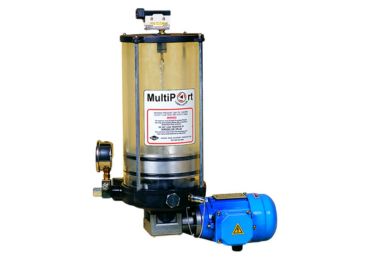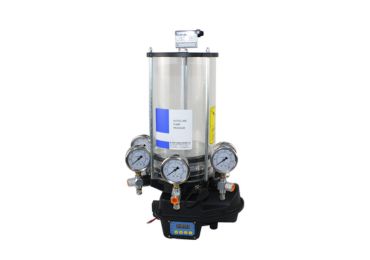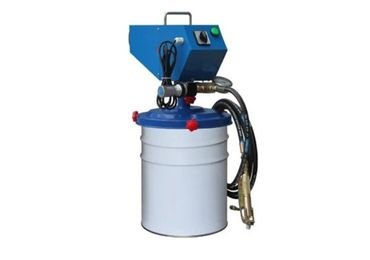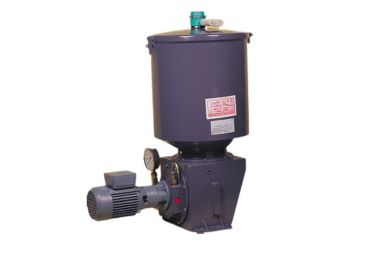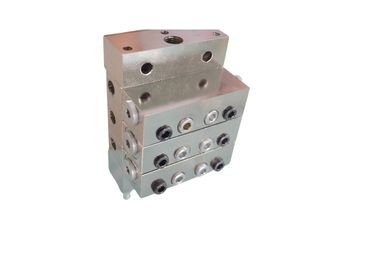
Heavy Duty DZGK-L Grease Pump
| Power voltage | DC12V/DC24V/AC220V |
| Timer | Yes |
| Motor Power | 50W |
| Max. pressure | 25MPa |
| Single outlet discharge | 10 ml/min per outlet |
| Number of outlet | 1~4 |
| Reservoir | 4L And 8L |
| Grease range | NLGI 000#~00#2 |
| Protection | IP65 |
AC380V Grease Pump
| Power voltage | 220V/380V/440V |
| Timer | Timer-1、Timer-2 or without Timer |
| Motor Power | 50W |
| Max. pressure | 25MPa |
| Single outlet discharge | 5.5ml/min per outlet |
| Number of outlet | 1~3 |
| Reservoir | 2L -12L(plastic or alu.) |
| Grease range | NLGI 000#~00#2 |
| Protection | IP65 |
| Timer | External timer |


DC12V/24V Grease Pump
| Power voltage | 12、24VDC |
| Timer | Timer-1、Timer-2 or without Timer |
| Motor Power | 50W |
| Max. pressure | 25MPa |
| Single outlet discharge | 5.5ml/min |
| Number of outlet | 1~3 |
| Reservoir | 2L (plastic) |
| Grease range | NLGI 000#~00#2 |
| Protection | IP65 |
| Interval | 2 minutes to 15 hours |
| Running time | 4 seconds to 37.5 minutes |
| Current | when loaded 3A |
FS Grease Pump
| Voltage | AC220V/DC24V |
| Reservoir | 4L-6L-8L-10L |
| Discharge | 2.5/3.5/5ml/min |
| Pressure | Max up to 25Mpa |
| Lubricant | NLGI #000-#2 |
| Level Switch | Option |


SK-505 Grease pump
| Model | SK-505 |
| Outlet | 1 outlet |
| Discharge | 13cc/min |
| Reservoir | 1L |
| Driven | Electrical |
| Weight | 1.9kg |
| Voltage | DC24V |
| Power | 25W |
| Level Switch | Option |
| Working pressure | 8Mpa |
Hand Grease Pump
| Model | P.N | PressureMPa) | Discharge per stroke (ml) | reservoir(L) | Lubrication system | Grease range | W.g.t |
| SG-1×0.4 | 20601 | 15 | 1 | 0.4 | PDI | NLGI 000#~0# | 1.9 |
| 20602 | 1 | 0.4 | PRG | ||||
| SG-1×1 | 20603 | 1 | 1 | PDI | 2.7 | ||
| 20604 | 1 | 1 | PRG | ||||
| Note: Optional outlet threads M8 × 1and M10 × 1 are available for your choice. Please specify the outlet and reservoir at time of order.
For Example: SG-1×0.4 20601 M8×1; |
|||||||

Y6020 Grease Pump
| Voltage | AC220V/DC24V/DC12V |
| Barrel Capacity | 20-30L |
| Discharge | 0.6L/Min |
| Pressure | Max up to 35Mpa |
| Lubricant | NLGI #000-#3 |
| Dimeter of Barrel | 280mm-320mm |
Bs-B Dual System Grease Pump
| Pressure | Discharge (ml/r) | Reservoir | Motor | Temperature(℃) | Wgt (kg) | |
| Power(kW) | Voltage(V) | |||||
| 0.4(MPa) | 120 | 30L | 0.37 | 380 | 0~80 | 56 |
| 0.75 | -20~80 | 64 | ||||
| 60L | 0.37 | 0~80 | 60 | |||
| 0.75 | -20~80 | 68 | ||||
| 235 | 30 | 1.5 | 0~80 | 70 | ||
| 60 | 74 | |||||
| 100 | 82 | |||||
| 365 | 60 | 74 | ||||
| 100 | 82 | |||||
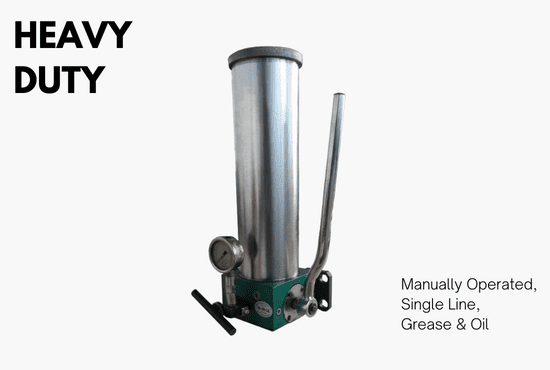
DA Hand Lubricator
| Reservoir | 2kg/4kg |
| 20-30L | |
| Discharge | 7.4cc/cycle |
| Viscosity | NIGI #000-#2 |
Pressure:25Mpa
Discharge:5.5ml/min
Power:DC12V,DC24V
Power:50W
Outlet:Rc1/4 Or M10x1
Reservoir:2Kg
Lubricant:NIGL#000-#2
Controller:Equipped
Pressure:25Mpa
Discharge:5.5ml/min
Power:DC12V,DC24V
Power:50W
Outlet:Rc1/4 Or M10x1
Reservoir:2Kg
Lubricant:NIGL#000-#2
Timer:Inside Timer Equipped
Pressure:25Mpa
Discharge:5.5ml/min
Power:AC220V Or AC380V
Power:50W
Outlet:Rc1/4 Or M10x1
Reservoir:2Kg-10Kg
Lubricant:NIGL#000-#2
Level Switch:Equipped
Timer:Outside Equipment
Pressure:25Mpa
Discharge:5.5ml/min
Power:AC220V or DC24V
Power:50W
Outlet:Rc1/4 Or M10x1
Reservoir:2Kg-10Kg
Lubricant:NIGL#000-#2
Level Switch:Equipped
Timer:Inside Timer
Outlet:1-5 Outlets
Reservoir:4kg or 8kg;
Lubricant: #000-#2 Grease;
Discharge:2.9cc/stroke;
Outlet:1-3 Outlets;
Operation Voltage:DC12V or Dc24V;
Outlet:8mm
Protection:IP67
Reservoir:20-30L
Discharge:0.6L/min
Pressure:35Mpa
Lubricant:#000-#3
Voltage:Dc24V/Ac220V
Pressure:40Mpa
Discharge:34ml/min,67ml/min
Power:370W
Voltage:AC380V
Reservoir:8L,15L,and 30L
NIGL:#000-#3
Pressure:25Mpa
Discharge:1.3ml/1.9ml/3.5ml/min
Power:370W
Voltage:AC380V
Reservoir:20L,30L,and 50L
NIGL:#000-#2
Outlets:1-24 Outlets
Air Grease Pump (3)
The ISOHITECH lubrication grease pump is a high-performance pump used for delivering grease lubricant to moving parts in industrial and automotive machinery. The pump is designed to provide precise amounts of grease to lubrication points, helping to reduce friction and wear on components.
ISOHITECH’s grease pump uses a durable construction with high-quality materials such as stainless steel and aluminum, which are resistant to corrosion and wear. It can deliver grease at various pressures and volumes, allowing for customized lubrication in different applications. The pump can be operated either manually or by compressed air, depending on the specific model.
One of the key features of ISOHITECH’s grease pump is its easy-to-use design, which allows users to quickly and efficiently add grease to the pump reservoir. The pump also includes a sight glass or dipstick for monitoring the level of the grease in the reservoir. Additionally, the pump is designed for easy maintenance, with simple disassembly for cleaning or replacing components.
Overall, the ISOHITECH lubrication grease pump is an essential tool for ensuring proper lubrication of machinery components, extending their lifespan and reducing maintenance costs.
A grease pump is a mechanical device that delivers lubricating grease to various points in industrial, automotive and other machinery. Grease is used to reduce friction between moving parts, prevent wear and tear, and protect against corrosion and contamination.
Grease pumps typically consist of a reservoir or container for holding grease, a pump mechanism for delivering the grease, and various control valves and fittings for directing the flow of grease to the specific lubrication points. They may be manually operated or powered by electricity, compressed air, or other means.
One of the key advantages of using a grease pump is that it allows for precise and controlled application of the lubricant, ensuring that the right amount of grease is delivered to each lubrication point. This can help to optimize equipment performance, minimize downtime due to maintenance issues, and extend the lifespan of machinery.
There are several different types of grease pumps available on the market, each designed for specific applications and requirements. The most common types of grease pumps include:
1. Manual grease pumps: These pumps are operated by hand or foot and are ideal for small-scale lubrication tasks.
2. Air-powered grease pumps: Also known as pneumatic grease pumps, these are powered by compressed air and are suitable for high-volume lubrication tasks.
3. Electric grease pumps: These pumps are powered by electricity and are ideal for continuous, high-volume lubrication tasks.
4. Battery-powered grease pumps: Similar to electric grease pumps, these pumps are powered by batteries and offer greater portability and flexibility.
5. Handheld grease guns: These devices are small, portable, and easy to operate, making them ideal for onsite applications or smaller machinery.
6. Centralized lubrication systems: These systems consist of a centralized pump that delivers grease to different points in the machinery through a network of pipes and tubes.
The choice of grease pump will depend on factors such as the nature and size of the machinery, the amount of lubrication required, and the working environment. It is important to select the right type of grease pump to ensure efficient and effective lubrication of machinery and prolong equipment lifespan.
No, you should not pump oil with a grease pump as they are designed to work specifically with grease. Grease pumps are designed to deliver thick, viscous lubricants such as grease that have a consistency similar to peanut butter or toothpaste. They operate by displacing the grease from the reservoir through a series of fittings and hoses to lubricate specific points in machinery.
Oil, on the other hand, has a much lower viscosity than grease and requires a different type of pump to be effectively dispensed. Pumping oil with a grease pump can result in damage to the pump’s seals and other components, as well as a reduction in lubrication performance.
If oil lubrication is required, then a dedicated oil pump should be used instead of a grease pump. Oil pumps are engineered to handle the thinner consistency of oil and provide efficient delivery to the lubrication points. It is important to always use the correct type of lubricant and pump for your specific application to ensure optimal results and equipment performance.
Truckers use grease as a lubricant to reduce friction and wear on various components of their vehicles. The heavy-duty trucks used for hauling goods over long distances are exposed to a lot of wear and tear as they travel across roads, highways, and other challenging terrain. Grease is used to protect important components of the vehicle such as wheel bearings, suspension systems, and chassis from damage caused by this wear and tear.
Grease helps to keep these components properly lubricated, reducing the risk of overheating, corrosion, and other types of damage that can lead to costly repairs and downtime. Properly lubricated components also help to ensure that the vehicle operates safely and reliably, which is especially important for truckers who spend long hours on the road.
Grease is particularly useful for truckers working in heavy-duty, high-stress environments because it has a higher viscosity than oil and is better able to stay in place under extreme conditions. This means that it is less likely to drip or run off of components, providing longer-lasting protection against friction and wear.
The process for filling a grease pump can vary depending on the specific type of pump and manufacturer instructions. However, here are some general steps that you can follow to fill a typical manual grease pump:
1. Clean the pump: Before filling the pump, make sure it is clean and free of any dirt or debris that may contaminate the grease.
2. Select the correct grease: Choose the type of grease that is recommended by the manufacturer for the specific application.
3. Remove the filler plug: Locate the filler plug at the top of the pump reservoir and remove it.
4. Fill the pump with grease: Insert the grease gun nozzle into the filler hole and begin pumping the grease into the reservoir. Depending on the size of the pump, you may need to fill it partially, and then pump it a few times to remove any air pockets before filling it up the rest of the way.
5. Check the level: Once the grease has been pumped into the reservoir, check the level to make sure it is filled to the appropriate mark on the sight glass or dipstick.
6. Replace the filler plug: Re-insert the filler plug and tighten it securely.
It is important to follow the specific instructions provided by the manufacturer for your pump, as some pumps may have unique features or requirements. Additionally, you should always wear protective gloves to avoid getting grease on your hands while filling the pump.
The frequency of greasing a truck will depend on several factors, including the make and model of the truck, the type of operation it is used for, the load capacity, and the operating conditions. In general, the recommended service intervals for greasing a truck can vary widely from daily to every six months, depending on usage.
As a guideline, most truck manufacturers suggest greasing the components every 10,000 miles or every 300 hours of operation. However, this may need to be more frequent in harsh operating conditions, such as extreme temperatures, excessive moisture, and dusty environments.
It is always best to consult the owner’s manual or maintenance guide for your specific truck to determine the recommended service intervals for greasing. Additionally, you should monitor the condition of the truck components regularly, checking for signs of wear or corrosion that may indicate that lubricants are needed more frequently.
Regular maintenance and lubrication of a truck can help to extend the lifespan of its components, reduce downtime due to repairs, and ensure that the truck operates safely and efficiently.








